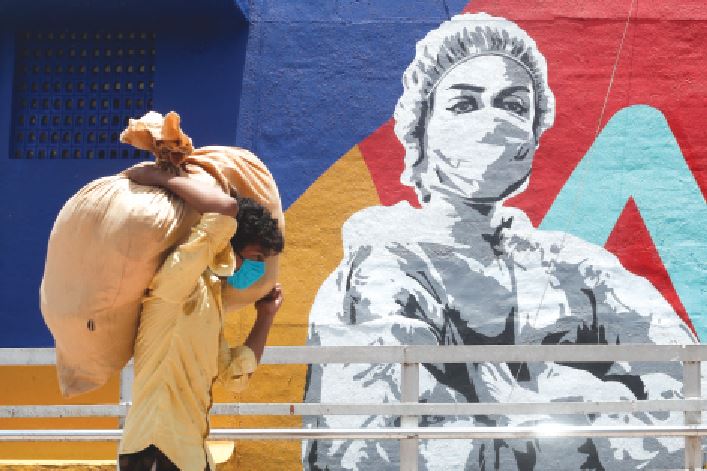Most of the emerging economies have government debt that is around 40% to 50% of their GDP, compared to that India’s debt-to-GDP ratio increased from 74 percent to 90 percent during the COVID-19 pandemic, the International Monetary Fund has said. A report by SHVETA MISHRA
 The moot question is why should people worry about the government debt. Those in the know of basic parameters of the economy point out “Why would anyone investing in stock markets fear to invest money in a company which is debt-ridden? Simply for the fact, when the next crisis comes that company might be wiped out. Similarly for countries, for international investors, the debt is going to show up in the sovereign credit ratings.”
The moot question is why should people worry about the government debt. Those in the know of basic parameters of the economy point out “Why would anyone investing in stock markets fear to invest money in a company which is debt-ridden? Simply for the fact, when the next crisis comes that company might be wiped out. Similarly for countries, for international investors, the debt is going to show up in the sovereign credit ratings.”
Looking for a silver lining even in such a scenario, the IMF has said that India’s debt-to-GDP ratio increased from 74 percent to 90 percent during the COVID-19 pandemic, but the International Monetary Fund finds that it expects this to drop down to 80 percent as a result of the country’s economic recovery.
According to the IMF, “In the case of India, the debt ratio at the end of 2019, prior to the pandemic, was 74 percent of Gross Domestic Product (GDP), and at the end of 2020, it is almost 90 percent of GDP. So, that’s a very large increase, but it is something that other emerging markets and advanced economies have experienced as well.” The report by IMF says, “And, for the case of India going forward, in our baseline forecast, we expect that the debt ratio will gradually come down as the economy recovers. In our baseline forecast under the assumption of healthy economic growth in the medium term, we see debt returning to about 80 percent over time.”
The IMF says that it is important to reassure the general public and investors that public finance is under control and the way to do so is through a credible medium-term fiscal framework. “This year, India has already announced its budget. It continues to be accommodative. It continues to support health, and it continues to support people. Over the next years, it is quite likely that the deficit will be reduced in part as the economy recovers”.
Earlier Fitch Ratings had hinted that the counter-cyclical policy fiscal support to India’s nascent economic recovery in the financial year may lead to an increase in public debt, which may be viewed negatively from a sovereign rating perspective, while also maintaining that higher government expenditure will support near-term recovery and increased infrastructure spending could boost sustainable medium-term growth rates.
The rating agency had said “India’s budget, presented by the government on 1 February, points to a loosening of fiscal policy to support the country’s ongoing economic recovery from the pandemic and will consequently lead to a rise in public debt. The debt/GDP trajectory is core to our sovereign rating assessment, meaning higher deficits and a slower consolidation path will make India’s medium-term growth outlook take on a more critical role in our analysis”.
The rating agency expects that economic growth will turn positive for Asia in the second half of this calendar year but the process of fiscal consolidation is set to be more protracted for the region. Within South Asia, it forecast that India’s ratio of general government (GG) debt-to-GDP will stabilize in the fiscal year ending March 2022 at just above 85 percent, from around 70 percent before the coronavirus shock, as its economy recovers from a steep downturn. “There is uncertainty about the outlook, however, relating to India’s post-pandemic growth potential and fiscal policies,” Fitch added. The majority of rated sovereigns in the Asia Pacific will see a sustained increase in debt as a share of GDP in 2020-2022.
Fitch says that the economic recovery will lift fiscal revenues and gradually reduce the need for crisis-related spending. Nevertheless, public debt will continue to rise as a share of GDP for more than half of Fitch-rated Asia Pacific sovereigns in both 2021 and 2022. This group includes some of the region’s biggest economies: China, South Korea, Australia, and Indonesia. Both Pakistan and Sri Lanka have GG debt-to-GDP levels above the median for their rating peer group.
“We believe Pakistan will start to lower its public debt-to-GDP ratio in 2022 under its IMF-supported programme, but we project a sustained increase for Sri Lanka throughout 2020-2022,” said Fitch. Significantly, it added, that economic forecasts for Asia as elsewhere remain subject to a high degree of uncertainty due to the evolution of pandemic. Geopolitical risks in particular trade tensions between the United States and China could also affect regional supply chains.
It is a hard fact that the raging second wave of Covid-19 infections in India is threatening to derail the gradual recovery the economy has achieved in the last one year. The Nomura India Business Resumption Index (NIBRI) indicates that it took almost a year for NIBRI to reach close to 100, which captures the pre-pandemic levels of activity. It reached 99.3 in the week ending February 21. The disruptive effect of the second wave can be understood from these numbers. It took seventeen weeks for NIBRI to reach from 83.3 to 99.3. But it has just taken eight weeks for it to undo those gains.
Experts believe that the worst is yet to come as more states resort to restrictions to prevent the surge in infections from overwhelming medical infrastructure. The economic impact of the second wave could intensify in the coming weeks, particularly through the mobility route, with the downside risk of spreading to the wider economy.
A major cause of worry is that India is currently experiencing a massive second wave of Covid-19 infections. The daily new cases have increased manifold since February 11, when it started rising again after declining for five months. According to the second advance estimates, 2020-21 is expected to suffer a GDP contraction of 7.96%. The 2021-22 Budget projected nominal GDP growth of 14.4% for the year. The pandemic has wielded a heavy blow to the Indian economy.
Experts say that when a larger proportion of the population is vaccinated, pent-up services demand could push GDP growth back up. Other experts believe the pace of vaccinations will be critical to minimizing the damage to the economy. If India manages to gradually ramp up vaccine supply and the vaccination rate rises from 3m doses a day now to about 5m doses a day by August, it could cover about 50% of the population (two doses per person) by the end-2021. But when will that be actually achieved is a million-dollar question?
tehelkaletters@gmail.com












